The Intel Core i3-12300 Review: Quad-Core Alder Lake Shines
by Gavin Bonshor on March 3, 2022 8:30 AM ESTConclusion
Over the last couple of years, AMD and Intel have been battling it out in the 'core wars.' The aim is to give users the largest core count – with many applications and games now benefiting from various multi-core optimizations – all for the best possible price. The other element of this fight has come down to IPC performance, with Intel and AMD flip-flopping for the top spot on its flagship desktop processors each time they both launch a new processor. Due to AMD's Zen architectures, Intel has been on the ropes in both performance and value for a while. Intel has been forced to push its innovation and boundaries to try and maintain what it previously had; a majority market share.
As we highlighted in our launch day Core i9-12900K review, Intel's new Alder Lake architecture brings new improvements and refinements to the table. This includes the two types of core, P-cores for performance and E-cores for efficiency/multi-threading. The P-cores are based on Intel's Golden Cove architecture, with the aim of offering applications performance when it needs it. The E-cores, or efficiency cores as Intel depicts them, are lower power, and one E-core equates to roughly 50-60% of the performance of one P-Core.
Focusing on Intel's Core i3-12300, it is the top SKU in its Core i3 lineup, with four P-cores, a base frequency of 3.5 GHz, and a turbo frequency of 4.4 GHz. In terms of power consumption, Intel has rated the i3-12300 at base frequencies with a TDP of 60 W and a 89 W TDP when at turbo clock speeds.
Intel's interpretation of turbo on Alder Lake, which is essential from a power draw perspective, is 'infinite turbo.' This means the processor will try and use as much turbo as and when it can. Fundamentally from a performance perspective, this is good as it will hit turbo clock speeds more frequently, but ultimately, it makes power consumption particularly variable, depending on the workload.
Intel Core i3-12300: Performance Analysis
It's all good and well having 16-core processors in a desktop platform, but ultimately, these typically cost upwards of $600. So what about CPUs for the more budget-conscious? Well, up until the launch of Intel's 12th Gen Core processors, AMD's Ryzen 5000 series had been at top of IPC, multi-threaded performance, and in a lot of scenarios, game performance and overall value too. One of AMD's most cost-effective processors remains the Ryzen 5 5600X, with six cores and competitive clock speeds at a reasonable price of $229.
In budget CPU space, things have now changed with both of Intel's Core i3 and i5 series slotting into that sub $300 market segment, with the Core i3 series significantly undercutting the 5600X in terms of price. In practice, Intel has the sub-$200 market entirely to itself right now, since AMD doesn't have access to the manufacturing capacity needed to address that market (and thus compete directly with the i3-12300).
Another factor that comes into play is Alder Lake's ability to support both DDR5 and DDR4 memory. We tested the Core i3-12300 with Windows 11 and DDR5-4800 CL40 memory for our Bench database data for comparative purposes. We did run tests with DDR5 4800 CL40 against DDR4-3200 CL22 on the Core i3-12300 on page 3, but the overall performance swing isn't as big as users might think, at least not in the grand scheme of things.
Let's take a look at some of the results and digest how the Intel Core i3-12300 stacks up against the competition:
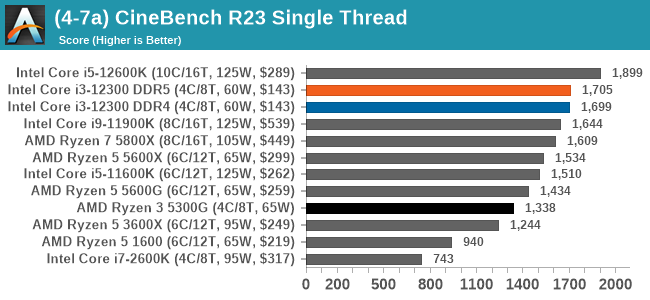
Looking at single-threaded performance in Cinebench R23, the Core i3-12300 and the four Golden Cove P-cores show dominance over previous generations of Intel's architecture, as well as AMD's Zen 3 cores. This typically changes each time AMD or Intel releases a new desktop architecture, and right now, Intel's 12th gen Core has the single-threaded crown.

In the multi-threaded section of Cinebench R23, this is where the cores or lack thereof come into play. Both AMD's Zen 3 6-core and 8-core processors have a considerable advantage in applications that can utilize all of the cores and threads available. Comparing DDR5 to DDR4 on the i3-12300, the DDR5-4800 CL40 performed around 8% better than DDR4-3200 CL22 in Cinebench R23's multi-threaded test.
For a more classic comparison, we also have the Core i7-2600K, which released over 10 years ago, was one of the most popular quad core chips ever produced. Comparing it directly to the Core i3-12300, the (much) newer i3 performs 2.3x better in terms of multi-threaded performance.
The only real competitor in the 4C/8T segment from AMD with Zen 3 cores, is the Ryzen 3 5300G APU. In our computational benchmarks, the Core i3-12300 has a consistent and distinct advantage in both single-thread and multi-threaded performance. So even if AMD could produce those chips in retail volumes, at this point they'd come in behind Intel's top quad.
Looking at other generational differences to AMD's Ryzen 3000 and 1000 series chips, the Core i3-12300 comfortably beats the Zen-based Ryzen 5 1600 (6C/12T) processor. For reference, it is only 12.4% slower than the Zen 2 based Ryzen 5 3600X (6C/12T) processor in Cinebench R23 multi-threaded performance.
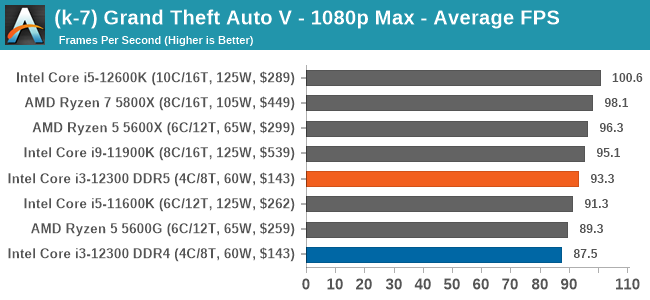
In our GTA V testing at 1080p at max settings with an NVIDIA RTX 2080 Ti, the Core i3-12300 is highly competitive with AMD's Ryzen 5000 six and eight-core models. This includes Intel's 11th generation processors, despite a lower core and thread count. The difference between DDR5 and DDR4 with the Core i3-12300 shows that using the platform with DDR5 memory was around 6% better in average frame rates over DDR4 when using Alder Lake's JEDEC memory settings.
While gaming is subjective as different game engines are optimized differently for CPU core count, performance in GPU intensive titles shows the Core i3-12300 in a favorable light, thus making it competitive for 1080p gaming.
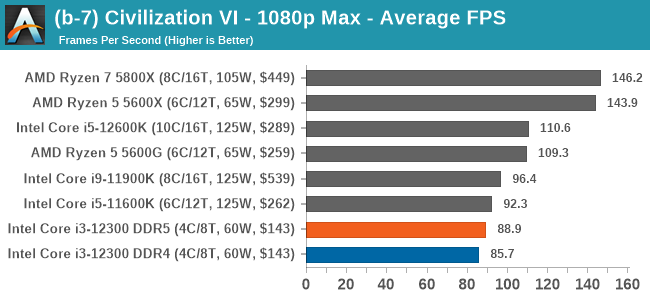
Looking at our Civilization VI benchmark performance at 1080p max settings, we see the limitations of where having a higher core count makes a substantial difference. Despite the 6C/12T and 8C/16T processors showing dominance, it's worth noting that the Core i3-12300 is still comfortably performing above 60 fps in average frame rates, with the 95th percentile frame rates also hovering close to 60 fps.
Touching on DDR5 versus DDR4 with the i3-12300 and in a more CPU favorable test such as Civilization VI, the DDR5 configuration performed 3.7% better in terms of average frame rates. Not a lot of difference considering the current price premium DDR5 has attached at the moment, but it's still an improvement nonetheless.
A broader selection of our CPU game testing results, including at other resolutions, can be found in our benchmark database: www.anandtech.com/bench. All gaming tests were with an RTX 2080 Ti for comparative purposes.
Intel Core i3-12300: Is Four Cores Enough in 2022?
The primary use case for Intel's Core i3 series includes lower-powered desktops, where tasks such as video rendering, encoding, and other content-creation tasks either aren't the target market, or are not the biggest use case for the market. As we've seen throughout our testing, the Intel Core i3-12300 is a fantastic processor for gamers on a budget, even with fewer cores than the competition, such as the Ryzen 5 5600 ($229), which is 6C/12T. You could say that the R5 5600X isn't really a competitor due to the price, but Intel is slotting in its Core i3 series well below AMD Ryzen 5000's entry point, and this makes things interesting.
| Intel Core i5 & i3 Processor Specifications (12th Gen Alder Lake) | ||||||||||
| AnandTech | Cores P+E |
P-Core Base |
P-Core Turbo |
E-Core Base |
E-Core Turbo |
L3 MB |
IGP | Base W |
Turbo W |
Price $1ku |
| i5-12600K | 6+4 | 3700 | 4900 | 2800 | 3600 | 20 | 770 | 125 | 150 | $289 |
| i5-12600KF | 6+4 | 3700 | 4900 | 2800 | 3600 | 20 | - | 125 | 150 | $264 |
| i5-12600 | 6+0 | 3300 | 4800 | - | - | 18 | 770 | 65 | 117 | $223 |
| i5-12600T | 6+0 | 2100 | 4600 | - | - | 18 | 770 | 35 | 74 | $223 |
| i5-12500 | 6+0 | 3000 | 4600 | - | - | 18 | 770 | 65 | 117 | $202 |
| i5-12500T | 6+0 | 2000 | 4400 | - | - | 18 | 770 | 35 | 74 | $202 |
| i5-12400 | 6+0 | 2500 | 4400 | - | - | 18 | 730 | 65 | 117 | $192 |
| i5-12400F | 6+0 | 2500 | 4400 | - | - | 18 | - | 65 | 117 | $167 |
| i5-12400T | 6+0 | 1800 | 4200 | - | - | 18 | 730 | 35 | 74 | $192 |
| i3-12300 | 4+0 | 3500 | 4400 | - | - | 12 | 730 | 60 | 89 | $143 |
| i3-12300T | 4+0 | 2300 | 4200 | - | - | 12 | 730 | 35 | 69 | $143 |
| i3-12100 | 4+0 | 3300 | 4300 | - | - | 12 | 730 | 60 | 89 | $122 |
| i3-12100F | 4+0 | 3300 | 4300 | - | - | 12 | - | 58 | 89 | $97 |
| i3-12100T | 4+0 | 2200 | 4100 | - | - | 12 | 730 | 35 | 69 | $122 |
Looking above at Intel's 12th generation Core i5 and i3 processor stack, only the top two Core i5 models feature E-cores, the Core i5-12600K and Core i5-12600KF. Nothing below these in the stack comes with E-cores, and instead, rely on the fully-fledged P-cores (Golden Cove), with 6 cores for all the Core i5s and 4 cores for the Core i3 models.
Comparing the Core i3-12300 (4C/8T) to other 4C/8T and 6C/12T SKUs such as the AMD Ryzen 5 5600X (6C/12T), the Core i3 is very competitive overall, but it does show its limitations in multi-thread applications and scenarios. As users would generally expect to be the case, the Core i3-12300 is Intel's most potent quad-core processor thus far. This isn't a surprise as the i3-12300 benefits from the Intel 7 manufacturing process, as well as generational increases to IPC performance, base, and turbo frequencies.
The decision on whether or not it's worth buying the Core i3-12300 over hex-core chips like the Ryzen 5 3600X or the Core i5-12600K comes down to the use case. Users planning on doing any form of rendering, encoding, or running multi-core optimized workloads will benefit from the extra cores and threads. Still, there's not that much difference between the Core i3-12300 and Ryzen 5 3600X in regards to gaming, or in other workloads that can't fill out more than 4 cores.
In gaming at 1080p and single-threaded applications, the Core i3-12300 excels and stakes its claim as a fantastic option for users on a budget. Looking further down the Alder Lake Core i3 stack, the Core i3-12100 ($122) could be the best value of the bunch, with a base frequency of 3.3 GHz and a turbo frequency of 4.3 GHz; just 100 MHz slower than the i3-12300. The onus is now on AMD to bring something competitive in the sub-$200 segment of the market, as right now, Intel holds all the marbles.
With an MSRP of $143, it's clear that the Intel Core i3-12300 represents excellent value for money in a current market where users are struggling to find value in components. It is clear Alder Lake has been a success for Intel, and the Core i3-12300 offers leading-edge quad-core performance on desktop for an equally great price.


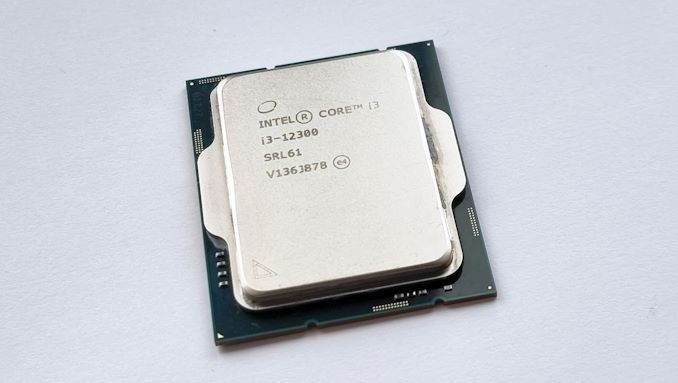
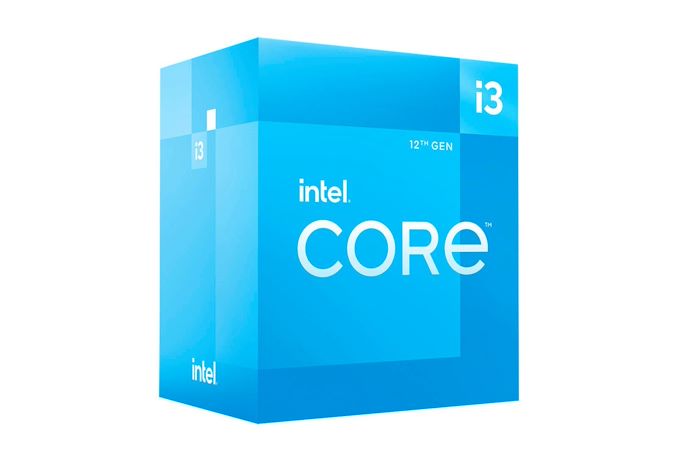








140 Comments
View All Comments
Alistair - Friday, March 4, 2022 - link
actually a quad core is great for 360hz gaming also, the problem is the locked clock speedif Intel would release an unlocked quad core that can run at 5ghz+ it would be a dream chip
that's why they don't release it, they want gamers to buy useless 16 core CPUs for gaming, as the game FPS is higher from cache and clock speed, not core count
mode_13h - Saturday, March 5, 2022 - link
I definitely agree that you shouldn't have to buy more cores just to get higher peak clock speeds.With Intel's Xeon CPUs, it would typically be the case that models with fewer cores would have higher base & peak clock speeds. I think that started to change when AMD setup their product stack so that each step enabled more cores and/or higher clock speeds. As Intel moved to 6- and 8-core mainstream CPUs, they did the same thing.
Where AMD sort of bucked the trend was with the 3300X. That little screamer was an absolute performance bargain. I almost bought one, a couple times - first, when it launched, and then I passed on it because it was selling above list price when it came back in stock in late 2020 or early 2021.
Anyway, I wish AMD would do something like that with a Zen3 or Zen3+, though it's looking unlikely.
Mike Bruzzone - Friday, March 4, 2022 - link
Hi Werewebb,Agreed, modern quads work great for Office essentials and home essentials including facility management and security.
I'm speaking English, are we communicating I think so, on what dialect on practice area can however lead to interpretative earning to confer in another practice area for comprehension cross practice cross functions achieving dialogue and I think so.
"An Alder Lake quad-core is equal or better than a Ryzen 5 2600. All benchmarks also show substantial improvements in 1% lows. What matters most is overall performance, not simply the number of cores."
Encoding, transcoding and compiling for octa centric advantages,
AMD with 3300x went after Ivy Bridge EE quad and won and there are plenty of priced right E5 1600 v2 quad and a bunch v2 hexa plus Haswell EE all cores just entered used market plenty of good choices especially if you have a board that can be upgraded.
Channel this last week;
Core Haswell desktop returns to secondary market + 46.6%, and mobile + 7.5% in prior eight weeks and the replacement trend is from Haswell forward in time.
Ivy Bridge EE + 161.11% octa/hexa return to used market prior eight weeks presents a telling indicator.
Haswell Extremes all SKUs + 180% in the prior eight weeks is a strong desktop upgrade indicator.
i7 Refresh + 14%, 4790 comes back to secondary + 17.8% and 4790K + 14% that is 10% of 90_
i5 Refresh 4590 comes back to secondary + 403% and 4690 sells down < 69% at 19% of 4590
i3 Refresh + 81% and 4150 comes back + 161%
Pentium Refresh + 5.5%
Celeron Refresh + 14.5%
i7 Original 4770 + 131% and K + 217% that is 24.1% of 70_
i5 Original + 169% and 4570 + 98%, 4570S + 952%, 4570T + 49.7% and 4570T is 26.3% of 4570_ all varients
i3 Original + 4% and 4130T + 13.7%
Pentium Original + 18.8% and G3220 comes back to secondary + 21.8% followed by 3420 + 19.2%
More in in comment line, several comments actually keep scrolling down until you find last week's Intel channel data and sales trend;
https://seekingalpha.com/instablog/5030701-mike-br...
mb
The vast majority of people are just fine running a modern quad-core.
nandnandnand - Thursday, March 3, 2022 - link
The explanation from here should be mentioned for AppTimer: GIMP since the results are so weird:https://www.anandtech.com/show/16214/amd-zen-3-ryz...
Maybe the test should be dropped entirely.
Slash3 - Thursday, March 3, 2022 - link
It is, in fact, a deeply stupid test with no value.mode_13h - Thursday, March 3, 2022 - link
"As it turns out, GIMP does optimizations for every CPU thread in the system, which requires that higher thread-count processors take a lot longer to run."Holy cow. I don't believe that. There's something else going on there, like maybe code using a stupid spinlock or something... which could actually be the case if some plugins or the core app used libgomp.
At the time that article was written, the only Big.Little CPUs were in phones (okay, let's forget Lakemont - nobody was running GIMP on a Lakemont). There was absolutely no reason for it to do per-thread optimizations!
lmcd - Friday, March 4, 2022 - link
No one ran anything on a Lakemont, as no one ran a Lakemont.mode_13h - Saturday, March 5, 2022 - link
Right. I was just noting that for completeness.nandnandnand - Sunday, March 6, 2022 - link
Lakefield, you mean! Although Intel does appear to have had a Lakemont, Google "Intel Lakemont" to find another deceased product.I have used GIMP on RPi4 (which can be rough but usable) so I can imagine Lakefield would be better. Lakefield was too expensive for relatively bad performance (couldn't run all 5 cores at once apparently). Intel gets another swing at it with the Pentium 8500 and other Alder Lake chips.
mode_13h - Tuesday, March 8, 2022 - link
Thanks for the correction.Yeah, I get the feeling Lakefield was testing out a few too many new technologies to be executed well. At least it served as a test vehicle for Big+Little and their die-stacking tech.